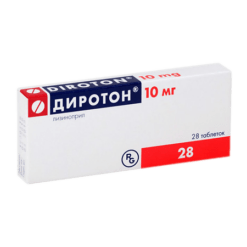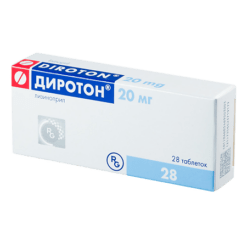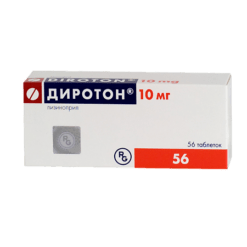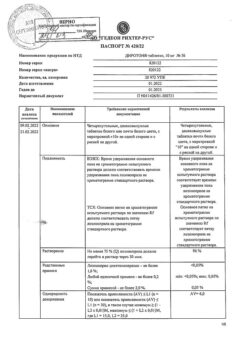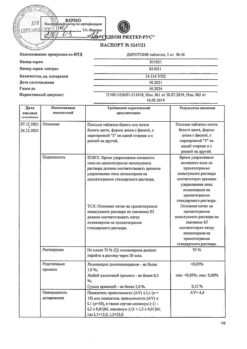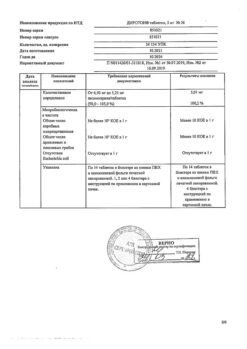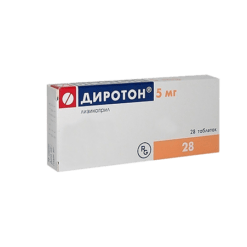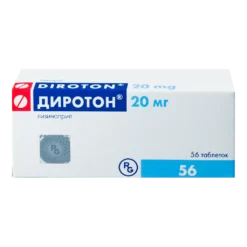No products in the cart.
Diroton Plus, 1.5 mg+5 mg 28 pcs
€13.78 €11.49
Description
Pharmacotherapeutic group: combined hypotensive agent (diuretic + ACE inhibitor).
ATC code: C09BA03
Pharmacological properties
Pharmacodynamics
Diroton® Plus is a combination drug with fixed doses of lisinopril and indapamide.
Indapamide
Indapamide is a sulfonamide derivative containing an indole ring. According to its pharmacological properties, indapamide is close to thiazide-like diuretics, which inhibit reabsorption of sodium ions in the cortical segment of the Genle loop. This is accompanied by increased excretion of sodium, chloride and potassium ions and, to a lesser extent, magnesium ions, which leads to increased diuresis and antihypertensive effect. In phase II and III clinical trials, the use of indapamide as monotherapy in doses that do not cause a pronounced diuretic effect caused a 24-hour antihypertensive effect.
The antihypertensive activity of indapamide leads to improvement of elasticity index of large arteries and to reduction of total peripheral and arteriolar resistance.
Indapamide reduces left ventricular hypertrophy.
In certain doses, the optimal therapeutic effect of thiazide and thiazide-like diuretics is achieved; however, further increasing the dose increases the frequency of side effects. Therefore, the dose should not be increased if the therapeutic effect is not achieved with the use of the drug at the recommended therapeutic doses.
In short-, medium-, and long-term studies in which patients with arterial hypertension have participated, it has been shown that indapamide:
- does not affect lipid metabolism, including triglyceride, cholesterol, low-density lipoprotein and high-density lipoprotein concentrations.
- does not affect carbohydrate metabolism, including in patients with diabetes.
Lisinopril
It is an inhibitor of angiotensin-converting enzyme ACE, which inhibits the conversion of angiotensin I to angiotensin II. A decrease in angiotensin II concentration leads to a direct decrease in aldosterone secretion. Lisinopril suppresses bradykinin degradation and increases prostaglandin synthesis.
Liminopril reduces total peripheral vascular resistance, blood pressure, preload and pulmonary capillary pressure. In patients with chronic heart failure, lisinopril increases the minute blood volume and increases myocardial tolerance to stress. It dilates arteries more than veins. Some effects are attributed to the effect on tissue reninangiotensin systems. Long-term use reduces myocardial hypertrophy and resistive arterial wall hypertrophy.
Lisinopril improves the blood supply to the ischemic myocardium.
In patients with chronic heart failure, ACE inhibitors increase life expectancy; in patients with a history of myocardial infarction without clinical manifestations of heart failure, lisinopril slows the progression of left ventricular dysfunction.
Lisinopril takes effect within 1 hour after oral administration.
The maximum effect is achieved within 6-7 hours; the duration of effect is 24 hours. In patients with arterial hypertension, the effect is seen within the first days of treatment; stable effect occurs within 1-2 months of treatment. No cases of significant increase in blood pressure (BP) after abrupt withdrawal of the drug have been reported. Lisinopril reduces both BP and albuminuria. In patients with hyperglycemia, lisinopril helps to restore impaired glomerular endothelial function. In patients with diabetes mellitus, lisinopril has no effect on plasma glucose concentration; the drug is not associated with increased risk of hypoglycemia.
Pharmacokinetics
Indapamide
The active ingredient is deposited on a special carrier matrix which allows slow controlled release of indapamide in the gastrointestinal tract.
Absorption: The released indapamide is quickly and completely absorbed in the gastrointestinal tract. Food intake slightly prolongs absorption time of indapamide, while it does not affect the amount of absorption. Cmax of indapamide is reached 12 hours after a single dose. When taking the drug repeatedly the changes in plasma concentration of the drug between doses are smoothed.
Individual variability in absorption is noted.
Distribution and protein binding: approximately 79% of the drug is bound to plasma proteins. The half-life (T½) is 14-24 hours (on average, 18 hours). Equilibrium concentrations are reached 7 days after initiation of therapy. Multiple administration does not lead to cumulation of the drug.
Elimation: indapamide is excreted mainly as inactive metabolite by urine (70% of the dose taken) and through the intestine (22%).
High-risk patients: pharmacokinetics of indapamide is not altered in patients with renal insufficiency.
Lisinopril
Absorption: When lisinopril is taken orally about 25% of the drug is absorbed in the gastrointestinal tract. Food intake has no effect on absorption. Mean absorption is 30%; bioavailability is 29%.
Distribution and binding to plasma proteins: maximum concentration in plasma (Cmax) is reached 6-8 hours after oral administration. The degree of binding to plasma proteins is low. Lisinopril poorly penetrates through the blood-brain barrier.
Metabolism: lisinopril is not biotransformed in human body.
Elimination: half-life (T½) is 12 hours.
Indications
Indications
Essential arterial hypertension (patients who require combination therapy).
Pharmacological effect
Pharmacological effect
Pharmacotherapeutic group: combined antihypertensive drug (diuretic + ACE inhibitor).
ATX code: C09BA03
Pharmacological properties
Pharmacodynamics
Diroton® Plus is a fixed-dose combination drug of lisinopril and indapamide.
Indapamide
It is a sulfonamide derivative containing an indole ring. In terms of pharmacological properties, indapamide is close to thiazide-like diuretics, which inhibit the reabsorption of sodium ions in the cortical segment of the loop of Henle. This is accompanied by an increase in the excretion of sodium, chloride and potassium ions and, to a lesser extent, magnesium ions, which leads to increased diuresis and an antihypertensive effect. In phase II and III clinical studies, the use of indapamide as monotherapy in doses that did not cause a pronounced diuretic effect caused a 24-hour antihypertensive effect.
The antihypertensive activity of indapamide leads to an improvement in the elasticity index of large arteries and a decrease in total peripheral and arteriolar resistance.
Indapamide reduces left ventricular hypertrophy.
At certain doses, the optimal therapeutic effect of thiazide and thiazide-like diuretics is achieved, however, with a further increase in dose, the frequency of side effects increases. Thus, the dose should not be increased if a therapeutic effect is not achieved when using the drug in recommended therapeutic doses.
In short-, medium- and long-term studies in patients with hypertension, indapamide has been shown to:
does not affect lipid metabolism, including the concentration of triglycerides, cholesterol, low and high density lipoproteins.
does not affect carbohydrate metabolism, including in patients with diabetes.
Lisinopril
It is an inhibitor of the angiotensin-converting enzyme ACE, which suppresses the conversion of angiotensin I to angiotensin II. A decrease in angiotensin II concentration leads to a direct decrease in aldosterone secretion. Lisinopril inhibits the degradation of bradykinin and increases the synthesis of prostaglandins.
Reduces total peripheral vascular resistance, blood pressure, preload and pulmonary capillary pressure. In patients with chronic heart failure, lisinopril increases minute blood volume and increases myocardial tolerance to stress. Dilates arteries more than veins. Some effects are explained by effects on tissue reninangiotensin systems. With long-term use, hypertrophy of the myocardium and the walls of resistive arteries decreases.
Lisinopril improves blood supply to ischemic myocardium.
In patients with chronic heart failure, ACE inhibitors increase life expectancy; in patients with a history of myocardial infarction without clinical manifestations of heart failure, lisinopril slows the progression of left ventricular dysfunction.
Lisinopril begins to act within 1 hour after oral administration.
The maximum effect is achieved within 6-7 hours; effect lasts 24 hours. In patients with arterial hypertension, the effect appears within the first days after the start of treatment; a stable effect occurs within 1-2 months of treatment. Cases of a pronounced increase in blood pressure (BP) after abrupt discontinuation of the drug have not been recorded. Lisinopril reduces both blood pressure and albuminuria. In patients with hyperglycemia, lisinopril helps restore impaired glomerular endothelial function. In patients with diabetes mellitus, lisinopril has no effect on plasma glucose concentrations; taking the drug is not associated with an increased risk of hypoglycemia.
Pharmacokinetics
Indapamide
The active substance is applied to a special carrier matrix, which provides a slow, controlled release of indapamide in the gastrointestinal tract.
Absorption: The released indapamide is rapidly and completely absorbed from the gastrointestinal tract. Eating slightly increases the absorption time of indapamide, but does not affect the amount of absorption. Cmax of indapamide is reached 12 hours after a single dose. With repeated administration of the drug, changes in the concentration of the drug in the blood plasma between doses of the drug are smoothed out.
Individual variability in the absorption value is noted.
Distribution and protein binding: approximately 79% of the drug is bound to plasma proteins. The half-life (T½) is 14-24 hours (average 18 hours). Equilibrium concentrations are achieved 7 days after the start of therapy. Repeated use does not lead to accumulation of the drug.
Excretion: indapamide is excreted mainly as an inactive metabolite through the urine (70% of the dose taken) and through the intestines (22%).
High-risk patients: The pharmacokinetics of indapamide do not change in patients with renal failure.
Lisinopril
Absorption: when lisinopril is taken orally, about 25% of the drug is absorbed from the gastrointestinal tract. Eating does not affect absorption. Average absorption level – 30%; bioavailability – 29%.
Distribution and binding to plasma proteins: maximum plasma concentration (Cmax) is achieved 6-8 hours after oral administration. The degree of binding to plasma proteins is low. Lisinopril does not penetrate the blood-brain barrier well.
Metabolism: lisinopril does not undergo biotransformation in the human body.
Elimination: half-life (T½) – 12 hours.
Special instructions
Special instructions
If you are hospitalized, tell your doctor that you are taking Diroton® Plus.
If you forget to take Diroton® Plus, wait and take your next dose at the usual time. Do not take two capsules to make up for a missed dose. When using the drug Diroton® Plus, it is necessary to take into account special instructions regarding the individual components of the drug.
Indapamide related
Liver dysfunction
When thiazide and thiazide-like diuretics are prescribed to patients with impaired liver function, hepatic encephalopathy may develop, especially in the presence of electrolyte imbalance. In this case, it is necessary to stop using diuretics.
Photosensitivity
When using thiazide and thiazide-like diuretics, cases of photosensitivity have been reported (see section “Side effects”). If photosensitivity develops during therapy, discontinuation of these drugs is indicated. If it is necessary to continue treatment, it is recommended to protect the skin from sunlight or artificial UV radiation.
Water and electrolyte balance
Sodium content in blood plasma
The sodium content in blood plasma must be determined before starting treatment. Regular monitoring of this parameter is indicated throughout the entire period of therapy. All diuretics can cause hyponatremia, which can sometimes have very serious consequences. Constant monitoring of sodium content in the blood plasma is necessary, since at the beginning of therapy such a decrease may not be accompanied by the appearance of pathological symptoms. Monitoring of sodium levels should be carried out especially carefully in patients with cirrhosis and in elderly patients (see sections “Side effects” and “Overdose”).
Potassium content in blood plasma
During therapy with thiazide and thiazide-like diuretics, a sharp decrease in the potassium content in the blood plasma, as well as the development of hypokalemia, is possible. It is necessary to reduce the risk of hypokalemia (< 3.4 mmol/l) as much as possible in the following patient groups: elderly patients, debilitated patients, patients receiving combination therapy with other antiarrhythmic drugs and drugs that can prolong the QT interval, patients with cirrhosis, peripheral edema and ascites, coronary insufficiency, heart failure. In such patients, hypokalemia enhances the toxic effects of cardiac glycosides and increases the risk of arrhythmias. In addition, patients with a prolonged QT interval should be considered high risk, regardless of the presence of the above conditions or the influence of medications.
Hypokalemia, as well as bradycardia, is a condition that contributes to the development of severe arrhythmias and, in particular, cardiac arrhythmias, which can be fatal. Regular monitoring of potassium levels in the blood plasma is indicated in these groups of patients, starting from the first week of treatment. If hypokalemia is detected, appropriate therapy is indicated.
Calcium content in blood plasma
It has been reported that thiazide and thiazide-like diuretics reduce the excretion of calcium by the kidneys, leading to a non-significant temporary increase in plasma calcium. Clinical hypercalcemia may result from previously undiagnosed hyperparathyroidism. In this case, it is necessary to discontinue diuretics before examining the function of the parathyroid glands.
Blood plasma glucose
Monitoring glucose concentrations is indicated in patients with diabetes mellitus, especially in the presence of hypokalemia.
Uric acid
Patients suffering from gout may experience an increase in the frequency of attacks or an exacerbation of gout.
Diuretics and kidney function
Thiazide and thiazide-like diuretics are most effective in patients with normal or slightly reduced renal function (plasma creatinine in adults <25 mg/l or 220 µmol/l). Plasma creatinine concentrations in elderly patients are assessed depending on age, body weight and gender.
At the beginning of treatment, patients experience a decrease in glomerular filtration rate due to hypovolemia, which may be associated with loss of water and sodium ions due to the action of diuretics. In this regard, an increase in the concentration of uric acid and creatinine in the blood plasma is possible. In the absence of renal dysfunction, such transient functional renal failure usually resolves without complications, but the general condition of patients may worsen in the presence of renal failure.
Athletes
Since indapamide is part of the drug Diroton® Plus, a positive doping test result in athletes is possible.
Lactose
The drug contains lactose, so it should not be taken by patients with rare hereditary galactose intolerance, lactase deficiency or glucose-galactose malabsorption syndrome.
Related to lisinopril
Symptomatic hypotension
Most often, a significant decrease in blood pressure is associated with hypovolemia caused by the use of diuretics, reducing the amount of salt in food, dialysis, diarrhea or vomiting. In patients with chronic heart failure, regardless of whether it is associated with renal failure, arterial hypotension may develop. It has been found that in patients with severe heart failure, this condition occurs more often due to the administration of high doses of diuretics, hyponatremia or impaired renal function. In such patients, careful medical supervision is required (careful selection of doses of lisinopril and diuretics is indicated). The same instructions apply to patients with coronary heart disease and cerebrovascular insufficiency, in whom a sharp decrease in blood pressure can lead to myocardial infarction or stroke.
If there is a significant decrease in blood pressure, the patient must take a horizontal position; intravenous administration of 0.9% sodium chloride solution is possible.
Transient hypotensive reactions are not a contraindication to the next dose of lisinopril.
In patients with chronic heart failure with normal or reduced blood pressure, the use of lisinopril may lead to a decrease in blood pressure; this usually does not serve as a reason to discontinue the drug. If arterial hypotension is accompanied by clinical manifestations, dose reduction or discontinuation of lisinopril should be considered.
In patients at risk of developing symptomatic arterial hypotension (on a low-salt or salt-free diet), regardless of the presence of hyponatremia, as well as in patients receiving diuretics in high doses, it is necessary to achieve compensation for these conditions (hypovolemia or sodium deficiency) before starting treatment. Monitoring of the effect of the initial dose of lisinopril on blood pressure is indicated.
Acute myocardial infarction
Standard treatment is recommended (thrombolytics, acetylsalicylic acid, beta-blockers).
Lisinopril can be used in combination with intravenous nitroglycerin or transdermal nitroglycerin.
In patients with acute myocardial infarction and the risk of further deterioration of hemodynamics, worsening of symptoms after the prescription of vasodilators, lisinopril therapy should not be started. These patients include those with systolic blood pressure <100 mmHg. Art. and patients with cardiogenic shock. In patients with systolic blood pressure < 120 mm Hg. Art. During the first three days after myocardial infarction, a dose reduction is indicated. In patients with systolic blood pressure <100 mm Hg. Art. The maintenance dose should be reduced to 5 mg (or temporarily to 2.5 mg). In patients with persistent arterial hypotension (systolic blood pressure <90 mm Hg for 1 hour or more), discontinuation of lisinopril is indicated.
Renal dysfunction
In patients with chronic heart failure, a significant decrease in blood pressure during the administration of ACE inhibitors can lead to worsening renal dysfunction. Cases of acute renal failure have been reported.
In patients with bilateral renal artery stenosis or renal artery stenosis of a single kidney, an increase in serum urea and creatinine concentrations was observed during the use of ACE inhibitors; Usually such disturbances were temporary and ceased after discontinuation of therapy. They occurred more often in patients with renal failure.
In patients with acute myocardial infarction and severe renal impairment (serum creatinine concentration >177 µmol/l and/or proteinuria >500 mg/day), lisinopril is contraindicated. If renal dysfunction develops during treatment (serum creatinine concentration >265 µmol/l or doubling compared to the initial value), discontinuation of lisinopril is indicated.
Allergic reactions, Quincke’s edema
In rare cases, during the use of ACE inhibitors, including lisinopril, the development of angioedema of the face, extremities, lips, tongue, epiglottis and/or larynx has been reported. In such cases, immediate discontinuation of lisinopril is required; Monitoring the condition of patients until symptoms are completely resolved is indicated. Typically, angioedema of the face and lips is temporary and does not require treatment; however, antihistamines may be prescribed.
Angioedema of the larynx can cause death. Swelling of the tongue, epiglottis, or larynx can lead to secondary airway obstruction. In this case, it is necessary to immediately administer 0.3-0.5 ml of a 1:1000 solution of adrenaline subcutaneously, and also ensure patency of the airways.
It was reported that angioedema occurred more often in black patients receiving ACE inhibitors than in patients of other ethnic groups.
In patients with a history of angioedema not associated with taking ACE inhibitors, the risk of developing angioedema when using ACE inhibitors is higher.
Anaphylactic reactions associated with desensitization by hymenoptera venom
In very rare cases, patients taking ACE inhibitors may develop life-threatening anaphylactic reactions during desensitization with hymenoptera venom, so it is necessary to temporarily discontinue ACE inhibitors before desensitization.
Patients on hemodialysis
Anaphylactic reactions have also occurred in patients undergoing hemodialysis using high-permeability dialysis membranes (eg, AN69) with concomitant use of ACE inhibitors. In such patients, the use of other dialysis membranes or other antihypertensive drugs is indicated.
Cough
Therapy with ACE inhibitors may cause cough, which should be taken into account when carrying out differential diagnosis. A prolonged dry cough usually stops after stopping ACE inhibitors.
Surgery/general anesthesia
The use of antihypertensive drugs during major surgery or during general anesthesia can lead to inhibition of the formation of angiotensin II due to compensatory secretion of renin. The significant reduction in blood pressure associated with this effect can be prevented by increasing circulating blood volume.
Patients taking ACE inhibitors should inform the surgeon/anesthesiologist before undergoing surgery (including dental procedures).
Blood plasma potassium
Cases of hyperkalemia have been reported.
Risk factors for hyperkalemia include renal failure, diabetes mellitus, therapy with potassium-sparing diuretics (spironolactone, triamterene and amiloride), use of potassium supplements and potassium-based salt substitutes, especially in patients with impaired renal function.
If combined use of lisinopril and these drugs is necessary, regular monitoring of potassium levels in the blood plasma is indicated.
Double blockade of the RAAS
It has been proven that the simultaneous administration of ACE inhibitors. Angiotensin II receptor blockers or aliskiren increases the risk of arterial hypotension, hyperkalemia and renal dysfunction (including acute renal failure). Therefore, it is not recommended to prescribe ACE inhibitors, angiotensin II receptor blockers, or aliskiren for dual blockade of the RAAS.
If there are absolute indications for double blockade of the RAAS, then it should be carried out under the careful supervision of a specialist with frequent monitoring of blood pressure, renal function and electrolyte levels.
ACE inhibitors and angiotensin II receptor blockers should not be used concomitantly in patients with diabetic nephropathy.
Impact on the ability to drive vehicles and machinery
There is no data on the effect of lisinopril on the ability to drive vehicles and operate machinery. However, the possibility of dizziness should be taken into account. In this regard, care must be taken when driving vehicles and operating machinery.
Indapamide does not cause impairment of psychomotor functions, however, in some patients, with a decrease in blood pressure, various individual reactions may develop, especially at the beginning of therapy or when an additional antihypertensive drug is prescribed to the main treatment regimen. In this case, the ability to drive vehicles and operate machinery may be reduced.
Active ingredient
Active ingredient
Indapamide, Lisinopril
Composition
Composition
For 1 capsule:
Active substances:
indapamide – 1,500 mg,
lisinopril dihydrate – 5.444 mg (equivalent to lisinopril – 5.000 mg).
Excipients:
lactose monohydrate – 84,000 mg,
calcium hydrogen phosphate dihydrate – 58.566 mg,
hypromellose (type 2208) – 49,500 mg,
mannitol – 16.670 mg,
corn starch – 12.150 mg,
microcrystalline cellulose, type 102 – 9,000 mg,
croscarmellose sodium – 3,000 mg,
talc – 2,500 mg,
magnesium stearate – 2.420 mg,
colloidal silicon dioxide – 0.750 mg,
opadry II white – 4.500 mg (contains: polyvinyl alcohol – 40.0%, titanium dioxide – 25.0%, macrogol-3350 – 20.20%, talc 14.80%),
hard gelatin capsule – 76 mg (contains: red iron oxide dye – 0.1180%, titanium dioxide – 2.2263%, gelatin – 83.1600%, water – 14.5000%).
Pregnancy
Pregnancy
Pregnancy
The use of Diroton® Plus during pregnancy is contraindicated.
Adequately controlled clinical studies of the use of Diroton® Plus in pregnant women have not been conducted. If pregnancy occurs, you must immediately stop taking Dirotonk Plus. Patients planning pregnancy should stop taking Diroton® Plus and consult a doctor to select another antihypertensive drug with an established safety profile during pregnancy.
Indapamide
In general, diuretics are contraindicated during pregnancy. It is prohibited to use these drugs to reduce physiological edema during pregnancy. Diuretics can lead to placental insufficiency and intrauterine development disorders.
Lisinopril
Taking ACE inhibitors by pregnant women in the 2nd-3rd trimester can lead to the death of the fetus or newborn. Careful monitoring of the condition of newborns and infants whose mothers took ACE inhibitors during the prenatal period is indicated to identify a possible significant decrease in blood pressure, oliguria and hyperkalemia. It is possible to develop oligohydramnios, as well as hypoplasia of the facial bones, deformation of the bones of the face and skull, hypoplasia of the lungs and impaired renal development in newborns.
Lisinopril can cross the placental barrier. Women of childbearing age should use reliable methods of contraception. Treatment with lisinopril should not be started during pregnancy.
Breastfeeding
The use of Diroton® Plus is contraindicated during breastfeeding.
Indapamide
Not recommended for nursing mothers (indapamide passes into breast milk).
Lisinopril
There is no data on the penetration of lisinopril into breast milk. During treatment with lisinopril, breastfeeding should be stopped.
Contraindications
Contraindications
Hypersensitivity to lisinopril or other ACE inhibitors.
Hypersensitivity to indapamide or other sulfonamide derivatives.
Hypersensitivity to the excipients of the drug.
History of angioedema, including angioedema, associated with the use of ACE inhibitors.
Hereditary or idiopathic angioedema.
Severe renal failure (creatinine clearance <30 ml/min).
Hepatic encephalopathy or severe liver dysfunction.
Hypokalemia.
Concomitant use of Diroton® Plus and drugs containing aliskiren in patients with diabetes mellitus or impaired renal function (glomerular filtration rate (GFR) <60 ml/min/1.73 m2).
Pregnancy or breastfeeding.
Age up to 18 years (efficacy and safety have not been established).
Lactose intolerance, galactosemia, glucose and galactose malabsorption syndrome.
With caution
Aortic stenosis, hypertrophic obstructive cardiomyopathy, cerebrovascular diseases (including cerebrovascular insufficiency), coronary heart disease, coronary insufficiency, severe autoimmune systemic connective tissue diseases (including systemic lupus erythematosus, scleroderma), myelosuppression, diabetes mellitus, hyperkalemia, bilateral renal artery stenosis, renal artery stenosis in patients with single kidney, condition after kidney transplantation, renal failure, azotemia, primary aldosteronism, salt-restricted diet, conditions associated with decreased circulating blood volume (including vomiting and diarrhea), elderly patients, liver failure.
Weakened patients or patients receiving combination therapy with other antiarrhythmic drugs (see section “Interaction with other drugs”); water-electrolyte imbalance; prolongation of the QT interval on the ECG; high concentration of uric acid in blood serum; hyperparathyroidism.
Side Effects
Side Effects
The frequency of adverse reactions is presented separately for lisinopril and indapamide. The following adverse drug reactions (ADRs) have been reported with the isolated use of lisinopril and indapamide.
The frequency is determined as follows:
Very often – 1/10 prescriptions (>10%).
Often – 1/100 prescriptions (>1% and <10%).
Uncommon – 1/1000 prescriptions (>0.1% and <1%).
Rarely – 1/10000 prescriptions (>0.01% and <0.1%).
Very rare – less than 1/10,000 prescriptions (<0.01%).
Frequency unknown (frequency cannot be estimated from available data).
Within each frequency group, adverse reactions are presented in order of decreasing severity.
Indapamide related
Most of the adverse reactions (laboratory and clinical changes) are dose-dependent.
Disorders of the blood and lymphatic system: very rarely – thrombocytopenia, leukopenia, agranulocytosis, aplastic anemia, hemolytic anemia.
Nervous system disorders: rarely – asthenia, headache, paresthesia, dizziness; frequency unknown – fainting.
Disorders of the cardiovascular system: very rarely – arrhythmia, severe arterial hypotension; frequency unknown – ventricular tachycardia of the “pirouette” type (life-threatening condition) (see sections “Interaction with other drugs” and “Special instructions”).
Gastrointestinal disorders: infrequently – vomiting; rarely – nausea, constipation, dry mouth; very rarely – pancreatitis.
Renal and urinary tract disorders: very rarely – renal failure.
Disorders of the liver and biliary tract: very rarely – impaired liver function; frequency is unknown – in case of liver failure, hepatic encephalopathy may develop (see “Contraindications” and “Special instructions”); hepatitis.
Skin and subcutaneous tissue disorders: hypersensitivity reactions, mainly dermatological, in patients with a predisposition to allergic and asthmatic reactions.
Often – maculopapular rash; uncommon – hemorrhagic vasculitis; very rarely – angioedema and/or urticaria, toxic epidermal necrolysis, Stevens-Johnson syndrome; frequency unknown – may worsen the condition in patients with acute systemic lupus erythematosus. Cases of photosensitivity reactions have been reported (see sections “Special instructions” and “Interaction with other drugs”).
Impact on the results of laboratory and instrumental studies: frequency unknown – prolongation of the QT interval on the ECG (see section “Special instructions”); increased concentrations of uric acid and glucose – in patients with gout and diabetes mellitus, treatment with thiazide and thiazide-like diuretics should be carried out with caution; increased activity of liver enzymes. In clinical studies, 10% of patients experienced hypokalemia (plasma potassium content less than 3.4 mmol/L) and 4% of patients – 3.2 mmol/L after 4-6 weeks of treatment. After 12 weeks, the potassium content in the blood plasma decreased by an average of 0.23 mmol/l; very rarely – hypercalcemia; frequency unknown – decrease in potassium content and development of hypokalemia, especially significant for patients at risk (see “Special Instructions”); hyponatremia, accompanied by hypovolemia, dehydration and orthostatic hypotension. A concomitant decrease in chloride may lead to compensatory metabolic alkalosis, but its frequency and severity are minor.
Related to lisinopril
The most common adverse reactions include dizziness, headache, fatigue, diarrhea, dry cough and nausea.
Disorders of the blood and lymphatic system: rarely – decreased hemoglobin and hematocrit; very rarely – leukopenia, neutropenia, agranulocytosis, thrombocytopenia, anemia; frequency unknown – erythrocytopenia.
Immune system disorders: uncommon – skin rash, itching; rarely – angioedema of the facial area, angioedema of the extremities, lips, tongue, epiglottis and/or larynx; very rarely – interstitial angioedema; frequency unknown – fever, positive antinuclear antibody test, increased erythrocyte sedimentation rate, eosinophilia, leukocytosis.
Mental disorders: infrequently – emotional lability; rarely – confusion.
Nervous system disorders: uncommon – paresthesia, drowsiness; rarely – asthenic syndrome; frequency unknown – twitching of the muscles of the limbs and face.
Cardiac disorders: uncommon – chest pain; rarely – tachycardia, bradycardia, increased symptoms of heart failure, atrioventricular conduction disturbances, myocardial infarction, palpitations.
Vascular disorders: often – marked decrease in blood pressure; rarely – orthostatic hypotension; frequency unknown – vasculitis.
Disorders of the respiratory system, chest organs and mediastinum: very rarely – bronchospasm; frequency unknown – shortness of breath.
Gastrointestinal disorders: infrequently – dyspepsia, dysgeusia, abdominal pain; rarely – dry mouth; very rarely – pancreatitis; frequency unknown – decreased appetite.
Disorders of the liver and biliary tract: very rarely – hepatocellular and cholestatic jaundice, hepatitis.
Disorders of the skin and subcutaneous tissues: infrequently – itchy skin; rarely – urticaria, alopecia; very rarely – sweating; frequency unknown – photosensitivity.
Musculoskeletal and connective tissue disorders: frequency unknown – myalgia, arthralgia/arthritis.
Renal and urinary tract disorders: often – renal dysfunction; rarely – acute renal failure, uremia; very rarely – oliguria, anuria; frequency unknown – proteinuria.
Disorders of the genital organs and mammary gland: uncommon – decreased potency.
Impact on the results of laboratory and instrumental studies: infrequently – hyperkalemia, hyponatremia; rarely – increased activity of liver enzymes, hyperbilirubinemia, increased concentrations of creatinine and urea.
If any of the side effects indicated in the instructions get worse, or you notice any other side effects not listed in the instructions, tell your doctor.
Interaction
Interaction
Interactions with indapamide
Undesirable combination of drugs
Lithium preparations
When indapamide and lithium preparations are used together, it is possible to increase the lithium content in the blood plasma due to decreased excretion, which leads to intoxication. If necessary, the combined use of diuretics with lithium preparations is possible, but it is necessary to carefully select the dose of the drugs and regularly monitor the lithium content in the blood plasma.
Combination of drugs requiring special attention
Drugs that can cause pirouette-type arrhythmias:
Class IA antiarrhythmic drugs (quinidine, hydroquinidine, disopyramide);
Class III antiarrhythmic drugs (amiodarone, sotalol, dofetilide, ibutilide);
Some neuroleptics: phenothiazines (chlorpromazine, cyamemazine, levomepromazine, thioridazine, trifluoperazine), benzamides (amisulpride, sulpiride, sultopride, tiapride), butyrophenones (droperidol, haloperidol);
Others: bepridil, cisapride, difemanil, erythromycin (intravenous (IV)), halofantrine, mizolastine, pentamidine, sparfloxacin, moxifloxacin, astemizole, vincamine (IV).
Increased risk of ventricular arrhythmia, in particular, cardiac arrhythmias – pirouette-type arrhythmias (risk factor – hypokalemia).
It is indicated to determine the potassium content in the blood plasma and, if necessary, its correction before starting the combined use of indapamide and the above drugs. It is necessary to monitor the patient’s clinical condition, the content of electrolytes in the blood plasma and ECG.
Patients with hypokalemia should take medications that do not cause cardiac arrhythmias.
Nonsteroidal anti-inflammatory drugs (for systemic use), including selective COX-2 inhibitors, salicylates in high doses (>3 g/day).
The antihypertensive effect of indapamide may be reduced.
With significant fluid loss, acute renal failure may develop (due to a decrease in glomerular filtration). Replenishment of fluid loss and careful monitoring of renal function at the beginning of treatment is indicated.
Angiotensin-converting enzyme inhibitors
The use of ACE inhibitors in patients with reduced sodium levels in the blood plasma (especially in patients with renal artery stenosis) leads to severe arterial hypotension and/or acute renal failure. For patients with arterial hypertension and a possible decrease in sodium content in the blood plasma due to the prescription of diuretics, the following is indicated:
Discontinue diuretics three days before prescribing ACE inhibitors. In the future, if necessary, it is possible to resume taking diuretics.
Or prescribing ACE inhibitors in lower doses with a gradual increase in dose if necessary.
In case of chronic heart failure, ACE inhibitors should be prescribed in lower doses, with a possible preliminary reduction in the dose of diuretics. In all cases, monitoring of renal function is indicated in the first week after the appointment of an ACE inhibitor (plasma creatinine concentration).
Other drugs that can cause hypokalemia: amphotericin B (iv), gluco- and mineralocorticosteroids (when used systemically), tetracosactide, laxatives that stimulate intestinal motility.
Increased risk of hypokalemia (additive effect).
Regular monitoring of potassium levels in the blood plasma and, if necessary, its correction are indicated. Patients receiving cardiac glycosides require special attention. It is recommended to use laxatives that do not stimulate intestinal motility.
Baclofen
Increased antihypertensive effects have been reported.
Patients need to replace fluid loss and monitor kidney function at the beginning of treatment.
Cardiac glycosides:
Hypokalemia enhances the toxic effects of cardiac glycosides.
With the combined use of indapamide and cardiac glycosides, monitoring of potassium levels in the blood plasma, as well as an ECG, is indicated. If necessary, therapy should be adjusted.
Combinations of drugs requiring attention
Potassium-sparing diuretics (amiloride, spironolactone, triamterene)
The combined administration of potassium-sparing diuretics and indapamide is effective in some patients. Despite this, the risk of developing hypokalemia (especially in patients with diabetes mellitus and renal failure) or hyperkalemia cannot be ignored.
Monitoring and, if necessary, correction of potassium levels in the blood plasma, as well as ECG monitoring are indicated.
Metformin
Functional renal failure, which can occur with the use of diuretics, especially loop diuretics, increases the risk of lactic acidosis with concomitant use of metformin.
Metformin should not be used if the creatinine concentration is more than 15 mg/l (135 µmol/l) in men and 12 mg/l (110 µmol/l) in women.
Iodine-containing radiocontrast preparations
Dehydration when using diuretics may increase the risk of acute renal failure, especially when using iodine-containing drugs in high doses.
It is necessary to replenish fluid loss before prescribing iodine-containing radiocontrast agents.
Tricyclic antidepressants, antipsychotics (neuroleptics)
Drugs of this class enhance the antihypertensive effect of indapamide and increase the risk of orthostatic hypotension (additive effect).
Calcium salts
When used in combination, the risk of hypercalcemia increases due to decreased renal excretion of calcium.
Cyclosporine, tacrolimus
It is possible to increase the concentration of creatinine in the blood plasma with unchanged concentration of circulating cyclosporine, even with normal circulating blood volume and sodium content in the blood plasma.
Corticosteroid drugs, tetracosactide (for systemic use)
Reduced antihypertensive effect (fluid and sodium retention caused by corticosteroids).
Interactions with lisinopril
Potassium supplements, potassium-sparing diuretics, or potassium-containing salt substitutes
Concomitant use of lisinopril with potassium-sparing diuretics (spironolactone, triamterene, amiloride), potassium supplements, and potassium-containing salt substitutes is associated with an increased risk of hyperkalemia, especially in patients with impaired renal function.
Diuretics
Concomitant use with other diuretics leads to a significant reduction
Other antihypertensive drugs
Combined use with other antihypertensive drugs leads to an additive effect.
Nonsteroidal anti-inflammatory drugs (NSAIDs), including acetylsalicylic acid at a dose of >3 g/day
Combined use with non-steroidal anti-inflammatory drugs (indomethacin, etc.), estrogens and adrenal stimulants leads to a decrease in the antihypertensive effect of lisinopril.
Lithium
Concomitant use with lithium preparations helps to slow down the excretion of lithium.
Antacids and cholestyramine
Concomitant use with antacids and cholestyramine leads to suppression of gastrointestinal absorption.
Ethanol
Ethanol enhances the effect of lisinopril.
Dual blockade of the renin-angiotensin-aldosterone system (RAAS) with angiotensin II receptor antagonists, ACE inhibitors or aliskiren
Clinical studies have shown that dual blockade of the RAAS during combined treatment with ACE inhibitors, angiotensin II receptor blockers or aliskiren leads to an increased incidence of side effects such as arterial hypotension, hyperkalemia and decreased renal function (including acute renal failure), compared with the use of only one drug affecting the RAAS.
Overdose
Overdose
Indapamide overdose
No toxic effects of indapamide were observed in case of overdose, even in very high doses (up to 40 mg, i.e. 27 times higher than the therapeutic dose).
Symptoms of acute drug intoxication depend primarily on water and electrolyte imbalance (hyponatremia, hypokalemia). Clinical manifestations of overdose may include nausea, vomiting, decreased blood pressure, convulsions, dizziness, drowsiness, confusion, polyuria or oliguria leading to anuria (due to hypovolemia).
Emergency measures include removing the drug from the body, gastric lavage and/or taking activated charcoal to restore water and electrolyte balance.
Lisinopril overdose
Symptoms: marked decrease in blood pressure, dry mouth, drowsiness, urinary retention, constipation, anxiety, irritability.
Treatment: symptomatic therapy, intravenous administration of 0.9% sodium chloride solution and vasopressors (in the absence of contraindications), blood pressure control, control of water and electrolyte balance. Hemodialysis is possible (see “Special instructions” – “Patients on hemodialysis”).
Storage conditions
Storage conditions
Store at a temperature not exceeding 25°C.
Keep out of the reach of children.
Shelf life
Shelf life
2 years. Do not use after the expiration date indicated on the package
Manufacturer
Manufacturer
Gedeon Richter, Hungary
Additional information
| Shelf life | 2 years. Do not use after the expiration date stated on the package |
|---|---|
| Conditions of storage | Store at a temperature not exceeding 25 ° C. Keep out of reach of children. |
| Manufacturer | Gedeon Richter, Hungary |
| Medication form | modified-release capsules |
| Brand | Gedeon Richter |
Other forms…
Related products
Buy Diroton Plus, 1.5 mg+5 mg 28 pcs with delivery to USA, UK, Europe and over 120 other countries.


